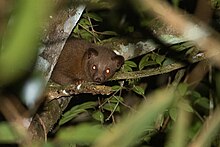Golden palm civet
| Golden palm civet | |
|---|---|
 |
|
| Scientific classification | |
| Kingdom: | Animalia |
| Phylum: | Chordata |
| Class: | Mammalia |
| Order: | Carnivora |
| Family: | Viverridae |
| Genus: | Paradoxurus |
| Species: | P. zeylonensis |
| Binomial name | |
|
Paradoxurus zeylonensis (Pallas, 1778) |
|
 |
|
| Golden palm civet range | |
The golden palm civet (Paradoxurus zeylonensis) is a palm civet endemic to Sri Lanka. It is listed as Least Concern on the IUCN Red List. Its distribution is severely fragmented, and the extent and quality of its habitat in Sri Lanka's hill regions are declining.
The golden palm civet is brown on the upper side, but individually variable from dark sepia to ochreous, rusty or golden-brown. The tips of the contour hairs are frequently lustrous, sometimes greyish. The legs are about the same tint as the back, but the tail and the face are sometimes noticeably paler, buffy-grey. The face does not have a pattern, and the vibrissae are dirty white. The hair in front of the shoulders radiates from two whorls and grows forward along the sides of the neck and the nape to the head. It also grows forward on the fore throat, radiating from a single whorl. The dorsal pattern consists of faint bands and spots that are slightly darker than the ground colour. The lower side is slightly paler and sometimes greyer than the upper.
The golden palm civet has two morphs — one golden and one dark brown, both of which are recorded from Sri Lanka. In 2009, several museum specimens were studied, and on this basis it was suggested to split these color morphs into separate species:
The golden palm civet is found in lowland rain forest, evergreen mountain forests, and also dense monsoon forest.
The golden palm civet is forest-dependent, yet tolerant of minor habitat modification where some continuous forest remains. It is arboreal, nocturnal, and solitary; its diet consists of fruits, berries, invertebrates, and a wide range of small vertebrates.
In Sri Lanka the golden palm civet is called pani uguduwa පැනි උගුඩුවා, sapumal kalawaddhaසපුමල් කලවැද්දා, or ranhothambuwa රන් හොතබුවා/hotambuwa හොතබුවා, by the Sinhala speaking community. Both golden and Asian palm civet are sometimes collectively called kalawedda in Sinhala and maranai (மரநாய்) in Tamil.
...
Wikipedia

